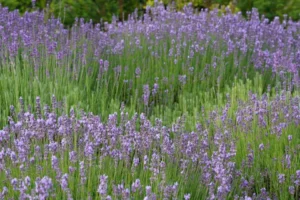
English Lavender (Lavandula angustifolia) is a fragrant and versatile herb known for its aromatic flowers and essential oils. Here are some tips on growing and caring for English Lavender:
Growing Conditions:
- Sunlight:
- Lavender thrives in full sunlight. Plant it in a location where it receives at least 6 to 8 hours of direct sunlight per day. Insufficient sunlight may lead to poor growth and reduced fragrance in the flowers.
- Soil:
- Lavender prefers well-draining soil with a slightly alkaline to neutral pH. Sandy or gravelly soils are ideal for preventing waterlogged conditions, which can be detrimental to the plant.
- Watering:
- Lavender is drought-tolerant and dislikes overly moist soil. Water the plant sparingly, allowing the soil to dry out between watering sessions. Once established, lavender is relatively low-maintenance in terms of water requirements.
- Spacing:
- Proper spacing is crucial for good air circulation and preventing diseases. Plant English Lavender about 12 to 18 inches apart to allow for adequate airflow between plants.
- Temperature:
- English Lavender is well-suited to temperate climates. It prefers cooler temperatures and can withstand mild winters. In areas with harsh winters, consider planting lavender in containers that can be brought indoors during freezing conditions.
Care Tips:
- Pruning:
- Regular pruning is essential for maintaining the shape of the plant and encouraging bushier growth. Prune English Lavender in the spring, cutting back about one-third of the previous year’s growth. Avoid cutting into the woody part of the stems.
- Fertilization:
- Lavender generally doesn’t require heavy fertilization. In fact, too much nitrogen can lead to excessive foliage growth at the expense of flower production. Use a low-nitrogen, well-balanced fertilizer in the spring, and avoid fertilizing late in the season.
- Mulching:
- Apply a layer of mulch around the base of the plant to help retain soil moisture, suppress weeds, and regulate soil temperature. Gravel or crushed stone can be excellent mulching materials for lavender.
- Pest Control:
- English Lavender is relatively resistant to pests, but it can sometimes be susceptible to issues like aphids or spider mites. Keep an eye out for pests, and if necessary, use insecticidal soap or neem oil to control infestations.
- Harvesting:
- Harvest lavender flowers just as they begin to open for the best fragrance and oil content. Cut the flower spikes, leaving some green foliage on the plant. Hang the harvested lavender bundles upside down in a dry, dark place to dry.
By providing the right growing conditions and following these care tips, you can enjoy the beauty and fragrance of English Lavender in your garden.

